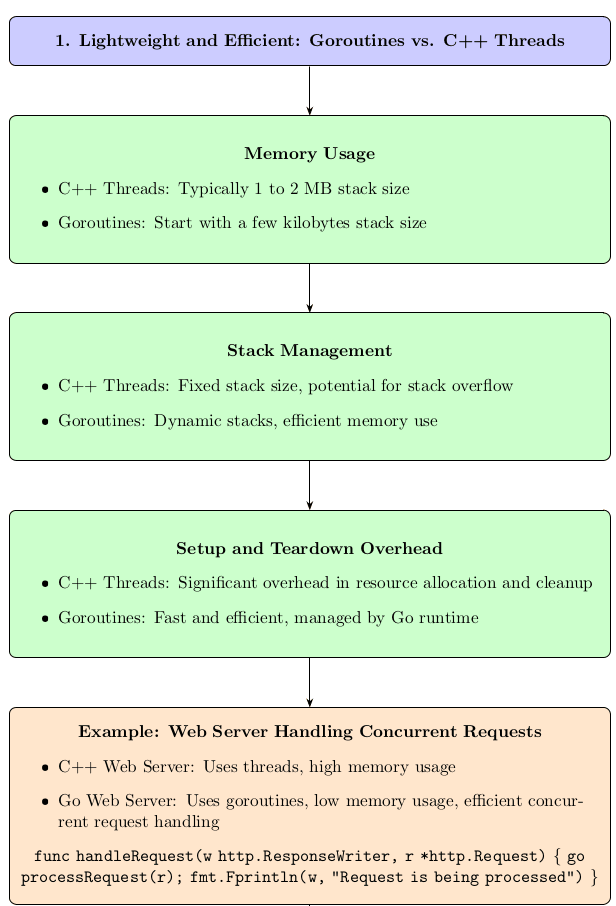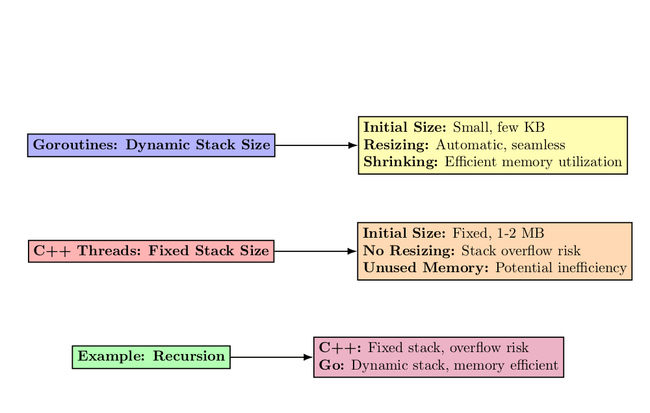Understanding Concurrency: Goroutines in Go vs. C++ Threads
Goroutines are lightweight with each requiring only a few kilobytes of stack memory . This allows for creating...

Amit
February 01, 2024
Understanding Concurrency: Goroutines in Go vs. C++ Threads:🔗

| Aspect | Goroutines in Go | C++ Threads |
|---|---|---|
| Implementation and Overhead | Goroutines are lightweight, with each requiring only a few kilobytes of stack memory. This allows for creating thousands of goroutines without significant memory overhead. | Threads in C++ are heavier, typically consuming more memory (around 1-2 MB per thread). This higher memory usage can be a limiting factor in the number of threads that can be actively managed. |
| Stack Management | Goroutines start with a small stack that can dynamically grow and shrink as required, optimizing memory usage and avoiding stack overflows. | C++ threads have a fixed stack size, which might lead to wasted memory (if the stack is too large) or stack overflow errors (if the stack is too small and cannot handle deep recursive calls). |
| Creation and Management | Creating a goroutine is as simple as prefixing a function call with the go keyword, simplifying concurrency management. Goroutines are managed by the Go runtime. |
Creating and managing threads in C++ requires more boilerplate code and a deeper understanding of threading libraries (like pthreads or std::thread). Thread lifecycle management is more complex. |
| Concurrency and Synchronization | Go provides built-in channels for communication between goroutines, making concurrent programming simpler and safer. Channels handle synchronization and messaging efficiently. | C++ lacks a direct equivalent to Go’s channels. Concurrency synchronization typically involves mutexes, condition variables, and other lower-level threading constructs, which can be more complex. |
| Scheduler and CPU Utilization | Go uses an M:N scheduler, multiplexing M goroutines onto N OS threads. This allows efficient CPU utilization and effective load balancing. | C++ relies on the OS's thread scheduler, adhering to a 1:1 threading model. This may lead to less efficient CPU utilization, especially with high concurrency. |
| Handling I/O-bound Tasks | Goroutines are highly efficient for I/O-bound tasks. They can perform non-blocking I/O operations, allowing other goroutines to run while waiting for I/O. | Handling I/O-bound tasks in C++ often involves blocking threads or implementing more complex asynchronous I/O patterns, potentially leading to underutilization of CPU resources. |
| Suitability for High Concurrency | Due to their lightweight nature and dynamic stack management, goroutines are well-suited for applications with high levels of concurrency. | While C++ threads can handle concurrency, managing a large number of threads can be resource-intensive and challenging due to higher memory and synchronization overhead. |

COMING SOON ! ! !
Till Then, you can Subscribe to Us.
Get the latest updates, exclusive content and special offers delivered directly to your mailbox. Subscribe now!